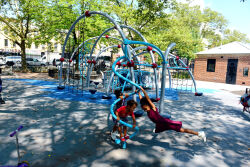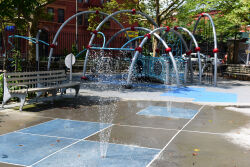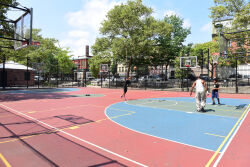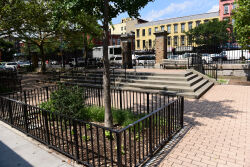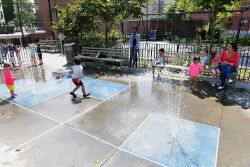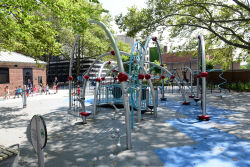Carmansville Playground
Carmansville Playground
In the July 1868 issue of The Atlantic Monthly, a poet named Charles Dawson Shanly (1811-1875) wrote an article about traveling the road along the Hudson River, in which he described the upper Manhattan countryside: “The road that leads by Washington Heights to New York…is the most picturesque route to the city. Trim hedges of beautiful flowering shrubs border the gravel walks that lead from the road to the villas. Cows of European lineage crop the velvet turf in the glades of the copses. Now and then the river is shut out from view, but only to appear again in scenic vistas.” Another contemporary account called it “the watering hole of the blue-blooded…where social delights were the study and business of summer life.”
Carmansville, from which Carmansville Park takes its name, was one of several villages that lined the Hudson River along this road. It was named for Richard Carman (1801-1867) a wealthy landowner in the area who made his fortune rebuilding much of New York City after the Great Fire of 1835.
Each of the villages had its own smithy, grocery store, school, and church. The southernmost village, Harsenville, occupied today’s Lincoln Center area. Striker’s Bay, a term still in use, encompassed the streets in the 80s and low 90s, and Bloomingdale Village extended from the 90s to 112th Street. The next village, between 112th Street and 140th Street, continues to be known as Manhattanville, followed by Carmansville from 140th Street to 158th Street. Inwood Village—today’s Inwood—was the northernmost of the hamlets.
By the end of the 19th century, the “scenic vistas” had become urban landscape, and the “watering hole of the blue-blooded” was home to a more diverse population. Several wealthy residents remained, and the area consisted mostly of middle class apartment buildings and tenements for the very poor. The turn-of-the-century transformation of the picturesque, meandering Bloomingdale Road into Broadway, the ultimate urban thoroughfare, epitomized the change.
Today Carmansville Park, located on Amsterdam Avenue between 151st Street and 152nd Street, is one of the few reminders of its namesake. The Committee on Streets, Highways, and Sewers named the new property in December 1913, choosing Carmansville to preserve the former designation of this section of the City. The property consists of two parcels: one acquired by condemnation in 1906, and a larger parcel granted to Parks in 1911 by the Department of Water Supply.
A village atmosphere still permeates the neighborhood surrounding the playground. The buildings, many of them brownstones built in the early 20th century, are small in scale, and the gently sloping streets recall the undulating meadows that once characterized this section of Manhattan, now known as Hamilton Heights or West Harlem.
This site is part of Parks' Community Parks Initiative—a multi-faceted program to invest in under-resourced public parks and increase the accessibility and quality of parks throughout the five boroughs.
Check out your park's Vital Signs
Clean & Safe
Green & Resilient
Empowered & Engaged Users
Share your feedback or learn more about how this park is part of a
Vital Park System

